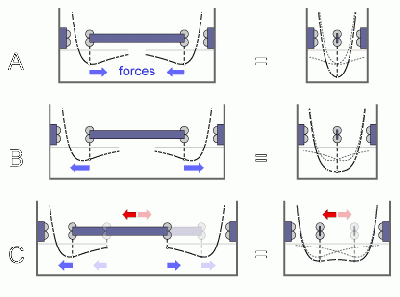Negative pressure bearings
In suberlubricating strained shell sleeve bearings when the gap between the axle and the sleeve is gradually increased in size by deliberate design changes, then it can get to the point where the axle and the sleeve go from mutually repelling each other (akin to a macroscale press fit) to mutually attracting each other. And that well before the situation becomes unstable and the axle snaps to one side of the sleeve.
Effectively there is a negative pressure between axle and sleeve:
- pulling the surface of the axle outward in all directions to the sleeve and
- pulling the surface of the sleeve inward to the axle
Maximizing of gap size leads to maximization of negative pressure and mimimization of potential waviness.
This leads to the following open questions:
- Does the maximally stable gap size correspond to minimal power dissipation? This would be a natural design goal for ultra low dissipation bearings for low loads but high speeds.
- Or is the gap size of minimal dissipation closer to the zero pressure point? Is there a notable speed dependence?
- How big is the gap typically just before the situation gets unstable?
(TODO: Answer above questions.)
(wiki-TODO: add a sketch to illustrate the situation)
(wiki-TODO: illustrate the range between where negative pressure starts and where the situation becones unstable via lennard jones potential and its first and second derivatives)
Range of presence and stability
The effect has its onset at the minimum of the Lennard Jones potential and at the zero of its first derivative (the force) where it flips from repulsive to attractive. The effect becomes unstable once the gap crosses the inflection point of the Lennard Jones potential which is the maximum of attractive (or minimum of repulsive) force and the zero of the second dreivative (of stiffness), where one goes from positive stiffness to negative stiffness. Negative stiffness means when you pull the counter-force gets weaker, you have a runaway process, the situation becomes unstable. For related infos check out the page: Energy, force, and stiffness.
External links
Archived from Eric Drexlers former website:
Related
- Superlubrication: Minimal friction superlubricity may lie in the negative pressure regieme. (TODO: invetsigate this)
- Stretching interpretation a bit negative pressure bearings maybe could be counted to the methods for levitation at the nanoscale.
- Nonbonded interactions
- Gemstone-like molecular element#Strained shell structures
- Levitation
Going the opposite way:
- High pressure -- Dissipative friction elements
- Design of Crystolecules#avoid too high interface pressure in sleeve bearings
Macroscale engineering terms like "press fit" may not be too well usable for strained shell bearings. Even slightly undersized undersized press fits might still suck axles in due to VdW force maximizung surface contact area.
